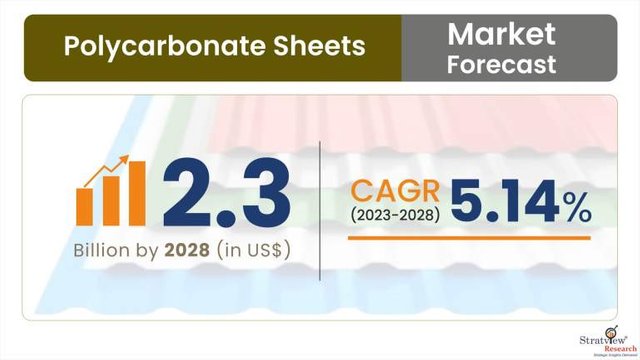Global Polycarbonate Sheets Market Insights: Growth Drivers and Challenges
The global polycarbonate sheets market has been experiencing notable growth in recent years, driven by the material's versatility and its applications across diverse industries. Polycarbonate sheets, known for their durability, transparency, and lightweight properties, are becoming an essential material in construction, automotive, electronics, and other sectors. This article explores the key growth drivers and challenges shaping the polycarbonate sheets market.
According to Stratview Research, the polycarbonate sheets market was estimated at USD 1.7 billion in 2022 and is likely to grow at a CAGR of 5.14% during 2023-2028 to reach USD 2.3 billion in 2028.
Growth Drivers
• Rising Demand in Construction and Architecture Polycarbonate sheets are widely used in construction for skylights, roofing, facades, and partitions due to their high impact resistance and UV protection. The increasing trend toward green building initiatives further boosts their adoption, as they offer energy efficiency and recyclability.
• Automotive and Transportation Applications In the automotive sector, polycarbonate sheets are replacing traditional glass for applications such as windows, headlight covers, and interior components. Their lightweight nature contributes to improved fuel efficiency and lower emissions, aligning with the industry's push toward sustainability.
• Growth in Electronics and Electrical Industries Polycarbonate sheets are favored in electronics due to their thermal resistance and electrical insulation properties. They are used in the manufacturing of LED light covers, switchboards, and other components, driven by the growing demand for electronic devices globally.
• Innovations and Technological Advancements Advances in manufacturing technologies have enabled the production of polycarbonate sheets with enhanced properties, such as improved UV resistance and fire retardance. These innovations are expanding their usability across critical industries, including aerospace and healthcare.
Challenges
• Volatility in Raw Material Prices Polycarbonate sheets are derived from bisphenol A (BPA), a petroleum-based product. Fluctuating crude oil prices significantly impact production costs, posing a challenge for manufacturers and end-users.
• Environmental Concerns Although polycarbonate sheets are recyclable, their production involves petrochemicals, raising concerns about environmental sustainability. Growing scrutiny over the carbon footprint of plastic-based materials could hinder market growth.
• Competition from Alternative Materials Polycarbonate sheets face competition from glass, acrylic, and other advanced polymers. While they offer superior impact resistance and flexibility, their higher cost compared to alternatives can limit adoption in cost-sensitive markets.
Conclusion
The global polycarbonate sheets market is poised for steady growth, fueled by its expanding applications and technological advancements. However, addressing challenges such as raw material volatility and environmental concerns will be crucial for sustained development. As industries continue to prioritize sustainability and innovation, the demand for polycarbonate sheets is expected to remain robust in the coming years.
